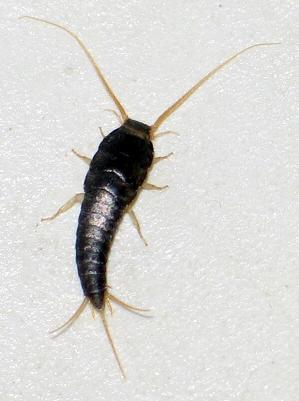Scientific classification:
Kingdom: Animlia
Phylum: Arthropoda
Class: Insecta
Order: Thysanura
Family: Lepismatidae
Occurrence: Lepismatidae is a family of primitive wingless insects belonging to the order Thysanura with about 190 described species. The members of the species use to live in southern countries, mostly in Spain, Greece, and Italy. Some species take advantage of the security which is provided by the ants. Therefore they are living together in anthill. Other species living with people, inside the house, as in our country the silverfish (Lepisma saccharina) does.
Description:their body is covered with shiny, silver scales, which peel off very easy, if somebody touch them. Lepismatidae are, elongated and flattened insects typically 03−25 millimetres (0.51−0.98 in) long. On their head are located two compounds eyes, which are perfectly suitable for their lifestyles.
The most familiar genus is the silverfish, Lepisma saccharina
Occurrence: silverfish normally live outdoors under rocks, bark and leaf mold, in the nests of birds and mammals, and in ant and termite nests. However, many are found in houses. The ideal habitat for a Silverfish is a dark, damp area. They are most often found in bathrooms or kitchens.
Description: silverfish are small, soft insects without wings. They have brown or silver-gray colour. They have three long cerci at the tips of their abdomens, one parallel to their body, one facing left, and one facing right. They also have long antennae. Despite other genus in this family, they have two compounds eyes which are well separated. They move very fast and in a fish like motion which is responsible for their common name.
Diet: silverfish like to eat carbohydrates, more specifically polysaccharides and starch, however, indoors they will feed on almost anything. A partial list includes cotton, book bindings, paper, carpet, linen, silk and synthetic fibres or even its own exuvia. That’s why, there is possibility to damage our clothing and text books in our home. It is possible for a Silverfish to live up to a year without eating during times of famine.
Reproduction: their reproduction including three phases. At first the female and male are standing facet to face and their trembling antennae touching, then repeatedly back off and return to this position. In the second phase the male runs away and the female chases him. In the third phase the male and female stand side by side and head-to-tail, with the male vibrating his tail against the female. Finally the male lays a spermatophore, a sperm capsule covered in gossamer, which the female takes into her body via her ovipositor to fertilize the eggs. The female lays the eggs in a group containing a few to 50 eggs. The eggs are white, oval shaped, tiny and are laid in cracks or crevices to protect them. Under ideal conditions, the eggs hatch in two weeks, but may take up to two months to hatch. The life of a silverfish begins when the nymph hatches from the egg. A silverfish nymph looks just like an adult silverfish does, just smaller. The nymphs spend between 3 to 24 months growing before they reach the adult stage. The life span of an adult Silverfish is then typically 2−3 years.
http://en.wikipedia.org/wiki/Silverfish http://www.sites.ext.vt.edu/departments/entomology/factsheets/silverfi.html
